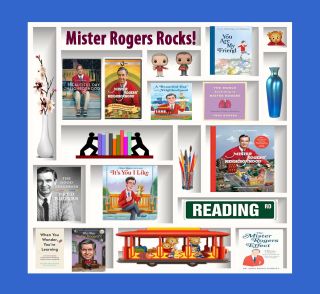Relationships
Mister Rogers Remembered Since We Need Him Now
It’s incumbent upon us to keep kindness and care alive in our broken world.
Posted February 25, 2023 Reviewed by Vanessa Lancaster
Key points
- Studies suggest that toddlers who watch Mister Rogers or Daniel Tiger’s Neighborhood are more patient, playful, cooperative, and social.
- As Tom Hanks took on the famous role, he portrayed humanity, similar to Rogers’ daily efforts to be genuine.
- Rogers was ahead of his time with social justice. He very subtly made television history.
- A minister, Rogers never used program as pulpit, yet in hard times, he said we are called to Tikkun Olam, “repairers of creation,” to help.
Twenty years ago, on a chilly February morning, we woke to a world without Fred Rogers, whom we grew up with and enthusiastically entrusted with the next generations. He was exceptional.
Now, marking the 20th anniversary of losing him, we’re convinced we need his guidance more than ever.
Any of us who met him treasure his gentle curiosity and how special we felt in his presence. Interviewing him, we didn’t wish to leave his den-like office at WQED-TV in Pittsburgh.

Thanks to well-documented online articles and videos, we can pay his messages forward with these parts of the Neighborhood blueprint:
Listen and Validate Emotion
Counseling teaches reflective listening and how to listen and paraphrase, a skill central to human interaction. Too often, humans ponder what to add next. They defend. React.
Reflective listening, which doesn’t imply agreement, pauses your agenda and aims to understand first. Fred listened intently and often agreed with the children since he was tuned into their fears and frustrations. “I like you just the way you are” can’t get any more validating–pure emotional gold.
Fred Rogers attended Pittsburgh Theological Seminary. When asked halfway into his curriculum what ministry he envisioned, television with children and families wasn’t the expected answer. “Nothing like that had ever been fashioned from Presbyterian fabric,” noted Maxwell King, biographer in The Good Neighbor: The Life and Work of Fred Rogers. Such a calling to minister through media was unmatched. Fred’s teachers were at a loss yet guided him to also study child development.1
Fred worked with renowned pediatricians, psychologists, and child development experts to develop scripts, which he crafted 95 percent by hand. Everything in the program was deliberate to validate reality and transition to the imagination.

Puppet conversations encouraged genuine emotion with shy Daniel’s self-doubts, Prince Tuesday’s worries about the world, and parent squabbles. Yes, life hands us the likes of self-absorbed King Friday, diplomatic Queen Sara, irascible Lady Elaine, and quirky X the Owl. Childhood prepares for adulthood. Rogers once stopped taping as a guest told Henrietta not to cry. He explained that when adults tamp down tears, they show their own trouble with emotion.
“Anything that’s human is mentionable, and anything that is mentionable is manageable,” Rogers once told me in an interview. Feelings expressed become less overwhelming, less scary.2
Curiosity Leads to Connection
Ahead of his time, Rogers used rituals to connect–the sweater, the sneakers, feeding the fish–because rituals of connection bolster close relationships.
Curiosity is the basis of When You Wonder, You’re Learning: Mister Rogers’ Enduring Lessons for Raising Creative, Curious, Caring Kids by Gregg Behr and Ryan Rydzewski. They explored the science behind Rogers’ iconic Neighborhood, revealing how creativity, curiosity, and collaboration as learning tools enhance well-being and academics, for all ages. Educators illustrate this in their work and after-school programs that the authors highlighted.3
Other Secrets to Our Success
“I worry that as the world grows meaner, kindness like Fred’s can look less and less attainable,” wrote Joanne Rogers, his widow, in the foreword of When You Wonder, You’re Learning. “I worry we’ll forget that Fred was just as human as we are.”
Tom Hanks portrayed Fred Rogers in It’s a Beautiful Day in the Neighborhood, telling Savannah Guthrie that Joanne Rogers’ was impressed that her husband wasn’t perfect; he worked at being a strong, kind self.4 The film shows us how. 5
Hanks said that pulling Rogers’ phrases and philosophy out of his pocket serves as a great harmonizer when stress and conflict fill his own life.
Anita Knight Kuhnley, in The Mister Rogers Effect: 7 Secrets to Bringing Out the Best in Yourself and Others from America’s Beloved Neighbor, wrote, “We need to keep the lessons he taught in our hearts and pass them on to others.”6
Adults now introduce youngsters to the Neighborhood, share quotes on social media, and give charitably to the Institute and production company that extend their blueprint for success.7
In researching Kindness & Wonder: Why Mister Rogers Matters Now More Than Ever, Gavin Edwards watched countless Neighborhood episodes readily accessible online. “Every morning I spent watching…strengthened my core, not my abdominal muscles, but my emotional well-being.”8
Gratitude and Attitude in Fred Fandom
It’s way cool to love Mister Rogers. As Hanks told a young father in the biopic, having children gives adults another chance to grow.
“Clearly, there’s still a cultural craving for what the program offered; its animated spinoff Daniel Tiger’s Neighborhood is streamed more than forty million times per month,” Behr and Rydzewski.
The Daniel Tiger Study through Texas Tech University found that two to four-year-olds who watched Daniel Tiger’s Neighborhood showed higher empathy and confidence in social situations and were better at recognizing emotions than others.9 When parents reinforced the program’s lessons, the outcomes rose. Another study suggests that watching Daniel Tiger’s Neighborhood helps children with an autism spectrum disorder to learn specific skills.10
“Won’t You Be My Neighbor?” outlined Fred’s work documentary style, with behind-the-scenes shenanigans plus interviews with family and cast.11

François Clemmons reflected on his surrogate father and recalled 1969 when Officer Clemmons and Fred cooled their feet in a plastic kiddie pool. The symbolism wasn’t lost. “At the time, pools were proxies for Jim Crow,” said Behr and Rydzewski. Where Black bathers gathered, white supremacists left nails on pool floors, poured in bleach, and closed pools, altogether.
In his early twenties, Clemmons initially turned down the invitation to be on Rogers’ program until he persuaded that Officer Clemmons would be a formidable model. It still took years for the opera singer and actor to “get” Mister Rogers.
“Fred was radical in that he personified this idea that you could be gentle, kind, loving, understanding, patient, and still be a man,” Clemmons told the Burlington Free Press. “Fred said, ‘Be kind, be kind, be kind.’ It changes how we view things.”12
Life comes with happiness and sadness, love and frustration, and hello and goodbye. Rogers lived by the idea of Tikkun Olam, or “repair the world,” and passed along joy, light, hope, faith, pardon, and love. Six secrets and being committed to our actions keep Fred Rogers alive in mind and heart.13
Which ones can you put into practice today?
Copyright © 2023 by Loriann Oberlin, MS
Related Psychology Today Posts: Mr. Rogers Inspires Us (2020) and Managing the Mad We Feel (2022)
References
1. M. King, The Good Neighbor: The Life and Work of Fred Rogers (New York: Abrams: 2018)
2. Interview in 1992 for United Airline’s Hemisphere’s (February 1993) with Loriann Oberlin
3. G. Behr and R. Rydzewski, When You Wonder, You’re Learning: Mister Rogers’ Enduring Lessons for Raising Creative, Curious, Caring Kids (New York: Hachette Go, 2021)
4. Tom Hanks full TODAY interview: https://tinyurl.com/Hanks-as-Rogers-on-TODAY
5. It's A Beautiful Day In The Neightborhood, Sony Pictures Home Entertainment, 2019. https://tinyurl.com/Tom-Hanks-Mr-Rogers
6. A.K. Kuhnley, The Mister Rogers Effect: 7 Secrets to Bringing Out the Best in Yourself and Others from America’s Beloved Neighbor (Michigan: Baker Books, 2020)
7. Fred Rogers Productions: https://www.fredrogers.org/donate/; Fred Rogers Institute: https://www.fredrogersinstitute.org/
8. G. Edwards, Kindness & Wonder: Why Mister Rogers Matters Now More Than Ever (New York: Dey St./Harper Collins, 2019)
9. Texas Tech Today/Daniel Tiger’s Neighborhood Research; https://today.ttu.edu/posts/2016/07/daniel-tiger
10. Behavioral Analysis in Practice, 2016 Aug 12;10(1):67-71. doi: 10.1007/s40617-016-0134-z. eCollection 2017 Mar.
11. Won't You Be My Neighbor? a Focus Features documentary, 2018; https://tinyurl.com/Rogers-Documentary
13. Fred Rogers PSA following 9/11: https://aish.com/jtube-mr-rogers-911-and-tikkun-olam/
Related Psychology Today Posts: Mr. Rogers Inspires Us (2020) and What Do You Do With the Mad That You Feel (2022)




